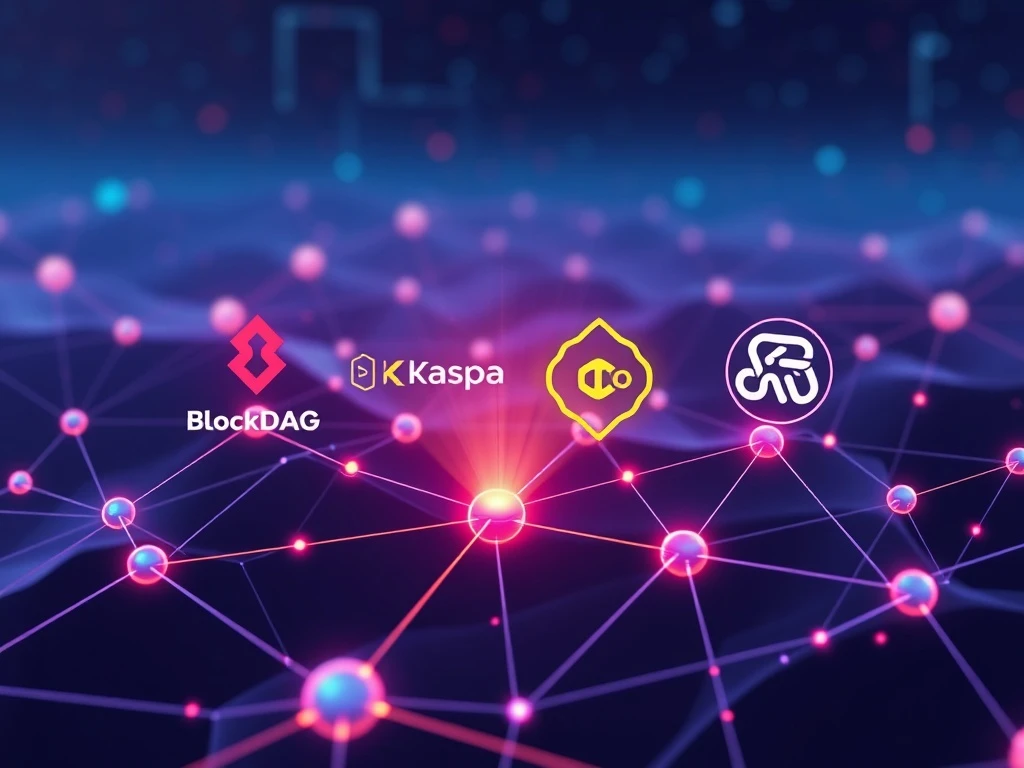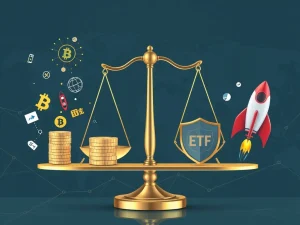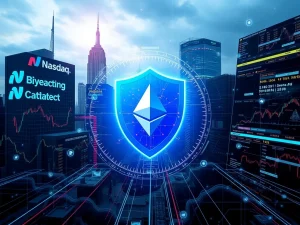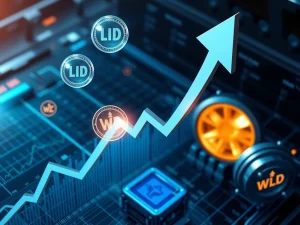BlockDAG Unlocking Future Gains: A 2025 Crypto Shift Driven by Utility and Scalable Infrastructure

The cryptocurrency market is in a constant state of evolution, and 2025 is poised to be a pivotal year. We’re witnessing a profound Crypto Shift 2025, moving beyond fleeting hype to prioritize projects with tangible utility, robust development, and truly scalable infrastructure. While meme coins continue to grab headlines, a deeper look reveals a growing investor appetite for assets that offer real-world value and sustainable growth. This article delves into four projects — BlockDAG, Kaspa, BONK, and CRO — that are not just surviving but thriving by aligning with this fundamental shift.
BlockDAG: Pioneering Layer 1 Innovation for the Future
In the rapidly evolving blockchain landscape, BlockDAG (BDAG) stands out as a formidable contender. Positioned as a Layer 1 blockchain, it leverages cutting-edge Directed Acyclic Graph (DAG) technology to achieve what many traditional blockchains struggle with: high throughput and decentralized scaling. Unlike linear blockchains, DAG allows for parallel processing of transactions, significantly boosting speed and efficiency without compromising security or decentralization.
The project’s early success is undeniable. Its presale has already amassed an impressive $353 million, with 24.3 billion coins sold. The locked price of $0.0016 until August 11 has created a sense of urgency and value for early participants. Beyond the technical prowess, BlockDAG has ingeniously integrated incentive mechanisms to foster community growth and sustained demand:
- “Buyer Battles” Mechanism: This unique feature rewards the top daily purchaser with a share of a substantial 25 million BDAG pool, encouraging consistent engagement and investment.
- Referral Program: A generous 25% of referral volumes are allocated as instant bonuses, creating a powerful viral loop that expands the user base organically.
These features create a self-sustaining demand loop, incentivizing both early and recurring participation. BlockDAG’s focus on a scalable Layer 1 architecture, combined with these innovative buyer-focused incentives, presents a dual-layer value proposition that sets it apart from many peers. As the 2025 launch window approaches, its presale metrics and reward mechanisms are likely to intensify competition for market share, positioning BDAG as a project to watch closely.
Kaspa: The BlockDAG That Delivers Instant Finality
When discussing high-performance blockchains, Kaspa (KAS) inevitably enters the conversation. It distinguishes itself through its unique blockDAG structure, which facilitates parallel block creation and near-instant transaction finality. This innovative approach addresses the long-standing blockchain trilemma of balancing scalability, security, and decentralization. Kaspa’s GHOSTDAG protocol is central to this, allowing it to process multiple blocks concurrently while maintaining a secure and ordered history.
What truly sets Kaspa apart is its commitment to transparency and fairness. With no pre-mine and a clear, open-source rule set, it has garnered significant trust and attracted a vibrant community of developers. This grassroots adoption has been a key driver behind its impressive 350% price surge in 2024. Analysts are now projecting a potential for a $1 price target in 2025, though it’s important to remember that such projections remain speculative and subject to market dynamics. Kaspa’s technical innovation ensures its long-term relevance in a market increasingly demanding speed and efficiency.
BONK: From Meme to Utility on Solana
Initially gaining traction as a meme coin, BONK, native to the Solana blockchain, has undergone a significant transformation. It has shed its purely speculative label by strategically integrating with established DeFi protocols and NFT tools within the Solana ecosystem, such as BonkSwap and BonkBot. This evolution signifies a broader trend in the crypto space where even meme-inspired tokens are seeking to establish genuine utility and long-term value.
A pivotal moment for BONK was the 1.6 trillion coin burn in 2025, a move that significantly tightened its supply cap. This deflationary measure, coupled with growing institutional interest in Solana-based assets, has helped to stabilize its market position. Despite occasional short-term price fluctuations inherent to the crypto market, BONK’s deep technical integration with Solana’s high-performance infrastructure provides a robust foundation for sustained utility. Its growing use cases in decentralized finance and non-fungible token markets demonstrate its commitment to becoming more than just a fleeting trend.
CRO: Cronos’s Ecosystem Powerhouse for Mainstream Adoption
Supported by Crypto.com, one of the world’s largest cryptocurrency platforms, Cronos (CRO) is a formidable player in the utility-driven crypto market. Its blockchain boasts impressive capabilities, processing up to 100,000 transactions per second (TPS), making it highly scalable for widespread adoption. CRO underpins a thriving DeFi ecosystem with over $500 million in total value locked (TVL), demonstrating its significant role in decentralized finance.
A strategic 2024 burn event, which reduced its 30 billion supply by 25%, has enhanced its scarcity and potential value. Cronos’s strategic integrations are key to its resilience and growth:
- Visa Integration: Its association with Visa through Crypto.com’s debit cards positions CRO for broader mainstream adoption, bridging the gap between traditional finance and crypto.
- NFT Ecosystem: Active participation in the NFT space further diversifies its utility and appeal.
- Payments and Staking: CRO’s utility in facilitating payments and enabling staking ensures its resilience against market volatility, providing clear incentives for holding and using the token.
CRO’s deep DeFi presence and its strategic moves towards mainstream utility cater to evolving investor priorities, solidifying its place as a cornerstone in the digital economy.
The Broader Crypto Shift 2025: What Drives Investor Attention?
The market’s current focus on projects like BlockDAG, Kaspa, BONK, and CRO underscores a broader trend: investors are increasingly prioritizing assets with clear use cases and sustainable development. The speculative frenzy of past cycles is maturing into a demand for fundamental value. This Crypto Shift 2025 is characterized by several key drivers:
| Driver | Description | Why it Matters |
|---|---|---|
| Utility & Real-World Use Cases | Projects solving real problems, enabling payments, powering DeFi, or facilitating digital ownership. | Provides intrinsic value beyond speculation, attracting long-term holders. |
| Robust Development & Innovation | Active development teams, continuous protocol upgrades, and groundbreaking technical solutions (e.g., DAGs, scaling solutions). | Ensures the project remains competitive and adaptable to future demands. |
| Scalable Infrastructure | Ability to handle high transaction volumes efficiently and cost-effectively without sacrificing decentralization. | Crucial for mass adoption and supporting complex applications. |
| Strong Ecosystem Growth | Growing developer community, partnerships, and user adoption across various applications built on the platform. | Indicates network effects and long-term viability. |
Investors are moving away from purely narrative-driven investments towards those backed by demonstrable technology and a clear roadmap for adoption. This shift favors projects that can prove their worth through performance and tangible benefits.
Navigating the Evolving Landscape: Actionable Insights
For investors looking to capitalize on the Crypto Shift 2025, understanding these underlying currents is crucial. While the allure of quick gains from meme coins persists, the sustainable opportunities lie in projects building foundational technology and expanding their ecosystems. Here are some actionable insights:
- Diversify with Utility: Consider allocating a portion of your portfolio to projects with clear utility, even if they don’t offer immediate exponential gains. These assets often provide more stable long-term growth.
- Research Beyond Hype: Look into whitepapers, development roadmaps, team backgrounds, and community engagement. Understand the technology and its practical applications.
- Assess Scalability: For any blockchain project, evaluate its ability to handle increasing transaction loads. Scalability is a non-negotiable for future mass adoption.
- Monitor Ecosystem Development: A thriving ecosystem with dApps, partnerships, and active users is a strong indicator of a project’s health and future potential.
- Understand Tokenomics: Pay attention to supply mechanisms, distribution, and utility of the native token. Deflationary measures or strong staking incentives can be positive signs.
The cryptocurrency market remains volatile, and all investments carry risk. However, by focusing on fundamental value drivers, investors can position themselves to benefit from the ongoing evolution of the digital asset space.
Conclusion: A New Era for Crypto Investment
The cryptocurrency landscape is undeniably maturing. The Crypto Shift 2025 signals a powerful transition towards projects that offer genuine utility, robust development, and scalable infrastructure. BlockDAG, with its innovative DAG technology and incentive mechanisms, Kaspa’s pursuit of instant finality and decentralization, BONK’s successful pivot from meme to utility on Solana, and CRO’s strategic drive for mainstream adoption, exemplify this new era. These projects are not just attracting investor attention; they are shaping the future of decentralized technology. As the market continues to evolve, prioritizing assets with clear use cases and sustainable development will be paramount for long-term success. The focus is now firmly on building, scaling, and integrating crypto into the real world, promising a more stable and impactful future for digital assets.
Frequently Asked Questions (FAQs)
Q1: What defines the ‘Crypto Shift 2025’ discussed in the article?
The ‘Crypto Shift 2025’ refers to a significant market trend where investor focus is moving away from purely speculative or meme-driven assets towards cryptocurrencies that demonstrate tangible utility, robust development, and scalable infrastructure. It emphasizes projects with real-world use cases and sustainable long-term growth potential.
Q2: How does BlockDAG (BDAG) achieve high throughput and scalability?
BlockDAG leverages Directed Acyclic Graph (DAG) technology as its Layer 1 blockchain architecture. Unlike traditional linear blockchains, DAG allows for parallel processing of transactions and blocks, significantly increasing throughput and enabling greater scalability without compromising decentralization or security.
Q3: What makes Kaspa (KAS) unique in terms of transaction processing?
Kaspa distinguishes itself with its unique blockDAG structure and the GHOSTDAG protocol. This allows for parallel block creation and near-instant transaction finality, meaning transactions are confirmed almost immediately. This approach aims to solve the blockchain trilemma by balancing high scalability with strong security and decentralization.
Q4: How has BONK transitioned from a meme coin to a utility token?
BONK, originally a meme coin on Solana, has transitioned to a utility token by integrating with various DeFi protocols and NFT tools within the Solana ecosystem, such as BonkSwap and BonkBot. A significant token burn in 2025 also reduced its supply, further solidifying its shift towards a more utility-driven and sustainable model.
Q5: What are the key factors driving Cronos (CRO) towards mainstream adoption?
Cronos (CRO) is driven towards mainstream adoption by its high transaction processing speed (up to 100,000 TPS), its robust DeFi ecosystem with significant Total Value Locked (TVL), and strategic integrations. Its association with Crypto.com and partnerships like Visa integration, along with its utility in payments and staking, position it strongly for broader use.
Q6: What should investors prioritize when looking at cryptocurrencies in this new market phase?
Investors should prioritize projects with clear utility and real-world use cases, active and robust development teams, proven scalable infrastructure, and evidence of strong ecosystem growth (e.g., dApps, partnerships, user adoption). Understanding tokenomics and long-term viability beyond short-term hype is also crucial.









